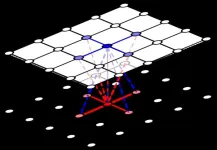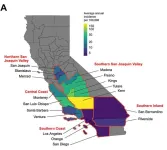(Press-News.org) Each agency representative presented the status of their current involvement in current and future planning for missions to Apophis (including extended mission for OSIRIS-REx, renamed OSIRIS-APEX, for NASA and the RAMSES mission for ESA) as well as the existing partnerships and mutual involvement in other agency’s missions, e.g. the infrared camera provided by JAXA in ESA’s mission Hera. Concepts to fly to Apophis, as well as reuse of existing payloads, spare parts and hardware, coordination of arrival time at Apophis of the different spacecraft, techniques to be demonstrated, science to be performed, and integration of scientific databases were also discussed during the meeting.
Although all risks of impacting the Earth have been ruled out for the April 2029 encounter, the asteroid Apophis will make its closest approach to Earth on Friday 13 April 2029, at an unprecedented distance. It will come closer to the Earth than the human-made geostationary satellites. It will even be visible to the naked eye speeding across the evening sky for an estimated 2 billion people spanning Western Europe and northern Africa. Apophis is one of the remnants of the bricks that formed planets and contain the record of the original composition of the solar nebula in which planets in our solar system formed. This once-per-7500-year opportunity to investigate the gravitational influence of the Earth on an asteroid should not be missed. Five years is short to develop and carry out the required investigations.
The agency representatives reaffirmed their strong desire to strengthen cooperation and coordination on such an important goal for humankind: both increasing our knowledge of the formation and history of the solar system and developing stronger capabilities in planetary defence.
The representatives stressed again the need for agencies to work jointly to prepare for this endeavour. This encounter offers a unique opportunity to inform the public at large about asteroids in particular and space research in general, and generate public outreach events and support material in the coming five years.
COSPAR is particularly proud to have been the initiator of this historic gathering, and stands ready to continue supporting this five-year effort as required.
Issued by COSPAR Communications:
Ms Leigh FERGUS-SWAN leigh.fergus@cosparhq.cnes.fr
https://cospar.world
Note to Editors
COSPAR, the largest international scientific society dedicated to promoting global cooperation in space research, was established in 1958. It serves as a neutral platform for scientific dialogue among scientists from around the world. Today, COSPAR comprises 46 national scientific institutions and 13 international scientific unions, with 13,000 space scientists actively participating in its activities, including attending assemblies, contributing to panels and roadmaps, and publishing in its journals.
COSPAR’s core mission is to facilitate dialogue and encourage international collaboration among space stakeholders across the globe. It operates through scientific commissions, panels and task groups that encompass all disciplines of space science, from Earth and atmospheric sciences to planetary science, astrophysics, solar and space plasma physics, and life and microgravity sciences.
A recent focus has been on strengthening ties between science and industry. This was achieved by forming the Committee on Industry Relations, which includes 18 leading aerospace companies worldwide. The Committee advises COSPAR on integrating industry capabilities into its activities, ensuring mutual benefits for both science and industry.
COSPAR web page
COSPAR on LinkedIn
COSPAR on X
COSPAR on Facebook
COSPAR on YouTube
COSPAR on Instagram
COSPAR on Mastodon
About NASA
NASA explores the unknown in air and space, innovates for the benefit of humanity, and inspires the world through discovery. For more than 65 years, NASA has made the seemingly impossible, possible. At its 20 centers and facilities across the country and with U.S. commercial companies and international partners, NASA leads studying Earth science, including climate, our Sun, solar system, and the larger universe. NASA conducts cutting-edge research to advance technology and aeronautics. NASA operates the world’s leading space laboratory, the International Space Station, and plans to establish a sustainable and strong exploration presence on the Moon this decade through the Artemis campaign. In 2016, NASA established the Planetary Defense Coordination Office (PDCO) to manage the agency's ongoing mission of finding, tracking, and better understanding asteroids and comets that could pose an impact hazard to Earth. PDCO leads activities for protecting Earth from Near Earth Object impacts.
About ESA
The European Space Agency (ESA) provides Europe’s gateway to space. ESA is an intergovernmental organisation, created in 1975, with the mission to shape the development of Europe’s space capability and ensure that investment in space delivers benefits to the citizens of Europe and the world. ESA has 22 Member States: Austria, Belgium, the Czech Republic, Denmark, Estonia, Finland, France, Germany, Greece, Hungary, Ireland, Italy, Luxembourg, the Netherlands, Norway, Poland, Portugal, Romania, Spain, Sweden, Switzerland and the United Kingdom. Latvia, Lithuania, Slovakia and Slovenia are Associate Members. ESA has established formal cooperation with four Member States of the EU. Canada takes part in some ESA programmes under a Cooperation Agreement. By coordinating the financial and intellectual resources of its members, ESA can undertake programmes and activities far beyond the scope of any single European country. It is working in particular with the EU on implementing the Galileo and Copernicus programmes as well as with Eumetsat for the development of meteorological missions.
About JAXA
The Japan Aerospace Exploration Agency (JAXA), was established as an Independent Administrative Agency in 2003, merging three aerospace organizations, the Institute of Space and Astronautical Science, the National Aerospace Laboratory, and the National Space Development Agency of Japan. JAXA is now positioned as a “National Research and Development Agency” as well as a “Core Implementing Agency” to support the Japanese Government in aerospace activities. JAXA has conducted asteroid explorations including Hayabusa and Hayabusa2 and provided the infrared camera in ESA’s mission Hera. The Agency executes ground observation including asteroids from Bisei Spaceguard Center.
About ASI
The Italian Space Agency (ASI) was established in 1988 with the task of preparing and implementing the Italian space policy in accordance with the Government guidelines. ASI is recognized as one of the most important global stakeholders in all space domains from human and robotic exploration to space science, propulsion, earth observation, navigation and telecommunications, thanks to and a continuous cooperation with the scientific community and Italian manufacturers and to fruitful international collaborations. The Agency coordinates the Italian participation in the European Space Agency (ESA), where Italy is the third largest contributor, and in the European Union programs and maintains international relations with numerous space partners and international organizations.
About KASA
The Korea AeroSpace Administration (KASA) was established on 27th May 2024, and announced its policy directions on 30th May, including asteroid exploration as one of the highest priorities. KASA is responsible for developing the national space strategy, implementing research and development projects, supporting the aerospace sector and promoting international cooperation.
END
Representatives from NASA, ESA, JAXA, ASI, KASA meet during COSPAR 2024 to reinforce cooperation and coordination for future missions to the asteroid Apophis
2024-09-03
ELSE PRESS RELEASES FROM THIS DATE:
Vision-based ChatGPT shows deficits interpreting radiologic images
2024-09-03
OAK BROOK, Ill. – Researchers evaluating the performance of ChatGPT-4 Vision found that the model performed well on text-based radiology exam questions but struggled to answer image-related questions accurately. The study’s results were published today in Radiology, a journal of the Radiological Society of North America (RSNA).
Chat GPT-4 Vision is the first version of the large language model that can interpret both text and images.
“ChatGPT-4 has shown promise for assisting radiologists in tasks such as simplifying patient-facing radiology reports and identifying ...
Minimal ADHD risk from prenatal cannabis use new study reveals
2024-09-03
A new study reveals nuanced findings on the neuropsychiatric risks of prenatal cannabis exposure. The research found a slight increase in the risk of ADHD and a heightened vulnerability to cannabis use in offspring. These results highlight the need for continued caution and further investigation into the long-term effects of cannabis use during pregnancy.
A new study led by Prof. Ilan Matok and Hely Bassalov PharmD from the Department of Clinical Pharmacy at the School of Pharmacy in the Faculty of Medicine at Hebrew University in collaboration ...
Study suggests gun-free zones do not attract mass shootings
2024-09-03
Gun-free zones have often been blamed for making schools, malls and other public areas more attractive to shooters; however, there have been no quantitative studies examining those claims. Now, in a first of its kind study published in The Lancet Regional Health Americas, researchers at UC Davis Health and other institutions have shown that gun-free zones may, in fact, reduce the risk of mass shootings.
"Our most significant finding is that gun-free zones don't attract active shooters,” said the study’s first author, Paul Reeping, ...
Mathematicians model a puzzling breakdown in cooperative behaviour
2024-09-03
Darwin was puzzled by cooperation in nature—it ran directly against natural selection and the notion of survival of the fittest. But over the past decades, evolutionary mathematicians have used game theory to better understand why mutual cooperation persists when evolution should favour self-serving cheaters.
At a basic level, cooperation flourishes when the costs to cooperation are low or the benefits large. When cooperation becomes too costly, it disappears—at least in the realm of pure mathematics. ...
Kessler Foundation scientists publish protocol for combining aerobic exercise and cognitive rehabilitation in multiple sclerosis
2024-09-03
East Hanover, NJ – September 3, 2024 – Researchers at Kessler Foundation have published a new clinical protocol examining the combination of aerobic exercise and cognitive rehabilitation to improve learning and memory in individuals with multiple sclerosis (MS) who have mobility disability. The article, “Rationale and methodology for examining the combination of aerobic exercise and cognitive rehabilitation on new learning and memory in persons with multiple sclerosis and mobility disability: Protocol for a randomized controlled trial,” was published online and will appear in print in Contemporary Clinical Trials, ...
New hope for progressive supranuclear palsy with innovative trial
2024-09-03
$75 million NIH grant could lead to the first effective drugs for a condition with few treatment options
A clinical trial that will test three drugs concurrently, and could include more, represents new hope for patients with progressive supranuclear palsy (PSP), an incurable neurodegenerative disorder that usually kills within seven years after symptoms start.
Researchers hope the trial, which will be led by UC San Francisco and conducted at up to 50 sites nationwide, will lead to the development of new therapies. There are currently no drugs to stall the disease’s deadly progression.
The ...
Mass General Brigham Gene and Cell Therapy Institute launches RNA Therapeutics Core
2024-09-03
The Mass General Brigham Gene and Cell Therapy Institute (GCTI) today announced it has launched the RNA Therapeutics Core, a first-of-its-kind, state-of-the-art facility and resource to advance the use of RNA technologies within and beyond the Mass General Brigham research ecosystem. This new Core is dedicated to accelerating the exploration of novel therapeutic targets to effectively translate RNA-based medicines into clinical practice by leveraging advanced RNA vectors and delivery systems.
Until now, a Core of this kind has not existed within an academic setting. With this launch, the RNA Therapeutics Core enables ...
Dangerous airborne fungus boosted by California droughts
2024-09-03
Valley fever is an emerging fungal disease in the western United States that most often causes flu-like symptoms, but can also cause dangerous or even deadly complications. By analyzing data on reported cases of Valley fever in California, which have increased dramatically over the last two decades, researchers from University of California San Diego and University of California, Berkeley, have identified seasonal patterns that could help individuals and public health officials better prepare for future surges in Valley fever cases. The findings also have important implications for how the changing climate can exacerbate the threat of infectious diseases. The findings are published in The ...
$1.8 million NIH grant to FAU engineering fuels quest to decode human evolution
2024-09-03
Natural selection is an important evolutionary force that enables humans to adapt to new environments and fight disease-causing pathogens. However, the unique footprints of natural selection in our genome can be buried beneath those left by other evolutionary forces. Thus, by leveraging information about multiple evolutionary forces, researchers can identify signatures of natural selection in the human genome, and ultimately determine its role in human adaptation and disease.
Low-cost DNA sequencing has ...
Communication helps parent relationships with new college students but has limits
2024-09-03
PULLMAN, Wash. -- When young adults first go off to college, more communication with parents generally leads to better relationships, but parents should avoid always initiating it, according to a study led by Washington State University researchers.
In a paper published in the journal Emerging Adulthood, WSU Assistant Professor Jennifer Duckworth and co-authors found that phone, text, video or in-person communication made first-year students feel better about the relationship with their parents. Students also felt better about the relationship when parents offered support or advice, and when they discussed important topics, such as studying and friendships. However, researchers found ...



